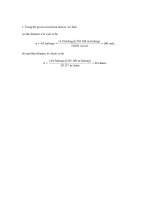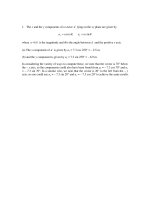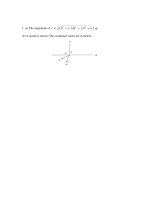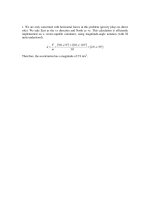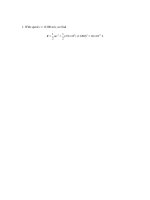Solution manual vector mechanics engineers dynamics 8th beer chapter 05
Bạn đang xem bản rút gọn của tài liệu. Xem và tải ngay bản đầy đủ của tài liệu tại đây (9.93 MB, 181 trang )
COSMOS: Complete Online Solutions Manual Organization System
Chapter 5, Solution 1.
\
Then
A, mm 2
x , mm
y , mm
xA, mm3
yA, mm3
1
200 × 150 = 30000
−100
250
− 30 000000
6 750 000
2
400 × 300 = 120000
200
150
24 000 000
18000000
Σ
150 000
21000 000
24 750000
X =
ΣxA 21 000000
=
mm
ΣA
150000
or X = 140.0 mm
Y =
ΣyA 24 750000
=
mm
ΣA
150 000
or Y = 165.0 mm
Vector Mechanics for Engineers: Statics and Dynamics, 8/e, Ferdinand P. Beer, E. Russell Johnston, Jr.,
Elliot R. Eisenberg, William E. Clausen, David Mazurek, Phillip J. Cornwell
© 2007 The McGraw-Hill Companies.
COSMOS: Complete Online Solutions Manual Organization System
Chapter 5, Solution 2.
A,in 2
x ,in.
y ,in.
xA,in 3
yA,in 3
1
10 × 8 = 80
5
4
400
320
2
1
× 9 × 12 = 54
2
13
4
702
216
Σ
134
1102
536
Then
X =
ΣxA 1102
=
ΣA
134
and
Y =
ΣyA 1102
=
ΣA
134
or
X = 8.22 in.
or Y = 4.00 in.
Vector Mechanics for Engineers: Statics and Dynamics, 8/e, Ferdinand P. Beer, E. Russell Johnston, Jr.,
Elliot R. Eisenberg, William E. Clausen, David Mazurek, Phillip J. Cornwell
© 2007 The McGraw-Hill Companies.
COSMOS: Complete Online Solutions Manual Organization System
Chapter 5, Solution 3.
Then
A, mm 2
x , mm
xA, mm3
1
1
× 90 × 270 = 12 150
2
2
( 90 ) = 60
3
729 000
2
1
× 135 × 270 = 18 225
2
Σ
30375
X =
90 +
ΣxA 3189375
mm
=
ΣA
30375
1
(135) = 135
3
2 460 375
3 189 375
or X = 105.0 mm
For the whole triangular area by observation:
Y =
1
( 270 mm )
3
or Y = 90.0 mm
Vector Mechanics for Engineers: Statics and Dynamics, 8/e, Ferdinand P. Beer, E. Russell Johnston, Jr.,
Elliot R. Eisenberg, William E. Clausen, David Mazurek, Phillip J. Cornwell
© 2007 The McGraw-Hill Companies.
COSMOS: Complete Online Solutions Manual Organization System
Chapter 5, Solution 4.
A,in 2
x ,in.
1
1
( 21)( 24 ) = 252
2
2
(13)( 40 ) = 520
Σ
2
( 21) = 14
3
21 +
1
(13) = 27.5
2
xA,in 3
y ,in.
40 −
1
( 24 ) = 32
3
20
772
Then
yA,in 3
3528
8064
14 300
10 400
17 828
18 464
X =
ΣxA 17828
=
in.
ΣA
772
or
Y =
ΣyA 18464
=
in.
ΣA
772
or Y = 23.9 in.
X = 23.1 in.
Vector Mechanics for Engineers: Statics and Dynamics, 8/e, Ferdinand P. Beer, E. Russell Johnston, Jr.,
Elliot R. Eisenberg, William E. Clausen, David Mazurek, Phillip J. Cornwell
© 2007 The McGraw-Hill Companies.
COSMOS: Complete Online Solutions Manual Organization System
Chapter 5, Solution 5.
A, mm 2
x , mm
2
1
π ( 225 )
2
1
( 375)( 225) = 42 188
2
4
−
= 39 761
4 ( 225 )
3π
= − 95.493
125
y , mm
xA, mm3
yA, mm3
95.493
− 3 796 900
3 796 900
5 273 500
3 164 100
1 476 600
6 961 000
75
81 949
Σ
Then
X =
ΣxA 1476600
mm
=
ΣA
81 949
or X = 18.02 mm
Y =
ΣyA 6961 000
mm
=
ΣA
81 949
or
Y = 84.9 mm
Vector Mechanics for Engineers: Statics and Dynamics, 8/e, Ferdinand P. Beer, E. Russell Johnston, Jr.,
Elliot R. Eisenberg, William E. Clausen, David Mazurek, Phillip J. Cornwell
© 2007 The McGraw-Hill Companies.
COSMOS: Complete Online Solutions Manual Organization System
Chapter 5, Solution 6.
1
2
3
−
π
4
−
A,in 2
x ,in.
y ,in.
xA,in 3
yA,in 3
17 × 9 = 153
8.5
4.5
1300.5
688.5
2
× ( 4.5 ) = −15.9043 8 −
π
4
( 6 )2 = − 28.274
Σ
4 × 4.5
4 × 4.5
= 6.0901 9 −
= 7.0901 − 96.857
3π
3π
−112.761
− 298.19
−182.466
905.45
393.27
10.5465
6.4535
108.822
Then
X =
ΣxA
905.45
=
ΣA 108.822
and
Y =
ΣyA 393.27
=
ΣA 108.22
or
X = 8.32 in.
or Y = 3.61 in.
Vector Mechanics for Engineers: Statics and Dynamics, 8/e, Ferdinand P. Beer, E. Russell Johnston, Jr.,
Elliot R. Eisenberg, William E. Clausen, David Mazurek, Phillip J. Cornwell
© 2007 The McGraw-Hill Companies.
COSMOS: Complete Online Solutions Manual Organization System
Chapter 5, Solution 7.
A,in 2
1
π (16 )
4
2
= 201.06
2
− ( 8 )( 8 ) = − 64
Σ
137.06
ΣxA 1109.32
=
in.
ΣA
137.06
Then
X =
and
Y = X by symmetry
x ,in.
4 (16 )
3π
= 6.7906
4
xA,in 3
1365.32
− 256
1109.32
or
X = 8.09 in.
or Y = 8.09 in.
Vector Mechanics for Engineers: Statics and Dynamics, 8/e, Ferdinand P. Beer, E. Russell Johnston, Jr.,
Elliot R. Eisenberg, William E. Clausen, David Mazurek, Phillip J. Cornwell
© 2007 The McGraw-Hill Companies.
COSMOS: Complete Online Solutions Manual Organization System
Chapter 5, Solution 8.
A, mm 2
x , mm
y , mm
xA, mm3
yA, mm3
1
35 343
63.662
0
2 250 006
0
2
− 4417.9
31.831
− 31.831
−140 626
140 626.2
Σ
30925.1
2 109 380
140 626.2
Then
X =
ΣxA 2109 380
=
ΣA
30 925.1
and
Y =
ΣyA 140 625
=
ΣA
30 925.1
or
X = 68.2 mm
or Y = 4.55 mm
Vector Mechanics for Engineers: Statics and Dynamics, 8/e, Ferdinand P. Beer, E. Russell Johnston, Jr.,
Elliot R. Eisenberg, William E. Clausen, David Mazurek, Phillip J. Cornwell
© 2007 The McGraw-Hill Companies.
COSMOS: Complete Online Solutions Manual Organization System
Chapter 5, Solution 9.
A
−
1
Therefore, for X =
4
π
2
Σ
π2
2
π
( 2r
4
2
2
r12
r22
− r12
4r1
3π
r13
π 2 4r1
− r1
=−
3
4 3π
4r2
3π
π 2 4r2 2r23
r2
=
3
2 3π
1
2r23 − r13
3
(
)
ΣxA 4r1
=
:
ΣΑ
3π
(
(
or
xA
)
)
4 2r23 − r13
4r1
=
3π
3π 2r22 − r12
or
x
π =
)
r 3
r13 2 2 − 1
r1
4
=
2
r
3π
r12 2 2 − 1
r1
r
2ρ 3 − 1
, where ρ = 2
2
r1
2ρ − 1
2 ρ 3 − 2πρ 2 + (π − 1) = 0.
Solving numerically for ρ and noting that ρ > 1:
Vector Mechanics for Engineers: Statics and Dynamics, 8/e, Ferdinand P. Beer, E. Russell Johnston, Jr.,
Elliot R. Eisenberg, William E. Clausen, David Mazurek, Phillip J. Cornwell
© 2007 The McGraw-Hill Companies.
r2
= 3.02
r1
COSMOS: Complete Online Solutions Manual Organization System
Chapter 5, Solution 10.
First, determine the location of the centroid.
y2 =
From Fig. 5.8A:
=
y1 =
Similarly
Then
Σ yA =
(π
2 sin 2 − α
r2 π
3
−α
2
(
2
cos α
r2 π
3
−α
2
)
(
)
(
)
2
cos α
r1 π
3
−α
2
2
cosα
r2 π
3
−α
2
(
)
(
)
A2 =
A1 =
( π2 − α ) r12
( π2 − α ) r22 − 23 r1
(
cosα
−α
2
π
)
2 3
r2 − r13 cosα
3
π
π
Σ A = − α r22 − − α r12
2
2
=
and
π
= − α r22 − r12
2
Y Σ A = Σ yA
(
Now
( π2 − α ) r22
)
π
2 3
Y − α r22 − r12 =
r2 − r13 cos α
2
3
(
)
Y =
(
)
2 r23 − r13 cos α
3 r22 − r12 π2 − α
Vector Mechanics for Engineers: Statics and Dynamics, 8/e, Ferdinand P. Beer, E. Russell Johnston, Jr.,
Elliot R. Eisenberg, William E. Clausen, David Mazurek, Phillip J. Cornwell
© 2007 The McGraw-Hill Companies.
)
( π2 − α ) r12
COSMOS: Complete Online Solutions Manual Organization System
Using Figure 5.8B, Y of an arc of radius
1
( r1 + r2 ) is
2
Y =
=
(π
sin − α
1
( r1 + r2 ) π 2
2
−α
2
(
)
)
1
cos α
(r1 + r2 ) π
2
−α
2
(
(
( r2 − r1 ) r22 + r1 r2 + r12
r23 − r13
=
r22 − r12
( r2 − r1 )( r2 + r1 )
Now
=
(1)
)
)
r22 + r1 r2 + r12
r2 + r1
r2 = r + ∆
Let
r1 = r − ∆
r =
Then
1
( r1 + r2 )
2
2
and
( r + ∆ ) + ( r + ∆ )( r − ∆ ) + ( r − ∆ )
r23 − r13
=
2
2
r2 − r1
(r + ∆) + (r − ∆)
=
2
3r 2 + ∆ 2
2r
In the limit as ∆ → 0 (i.e., r1 = r2 ), then
r23 − r13
3
= r
2
2
2
r2 − r1
=
so that
Y =
3 1
× (r1 + r2 )
2 2
2 3
cos α
× ( r1 + r2 ) π
3 4
−α
2
Which agrees with Eq. (1).
Vector Mechanics for Engineers: Statics and Dynamics, 8/e, Ferdinand P. Beer, E. Russell Johnston, Jr.,
Elliot R. Eisenberg, William E. Clausen, David Mazurek, Phillip J. Cornwell
© 2007 The McGraw-Hill Companies.
or Y =
1
cos α
!
( r1 + r2 ) π
2
−α
2
COSMOS: Complete Online Solutions Manual Organization System
Chapter 5, Solution 11.
Then
X =
A,in 2
x ,in.
xA,in 3
1
27
8.1962
221.30
2
15.5885
3.4641
54.000
3
−18.8495
3.8197
−71.999
Σ
23.739
ΣxA 203.30
=
ΣA
23.739
203.30
or
X = 8.56 in.
and by symmetry
Vector Mechanics for Engineers: Statics and Dynamics, 8/e, Ferdinand P. Beer, E. Russell Johnston, Jr.,
Elliot R. Eisenberg, William E. Clausen, David Mazurek, Phillip J. Cornwell
© 2007 The McGraw-Hill Companies.
Y =0
COSMOS: Complete Online Solutions Manual Organization System
Chapter 5, Solution 12.
1
2
A, mm 2
x , mm
y , mm
xA, mm3
yA, mm3
1
( 240 )(150 ) = 18 000
2
160
50
2 880 000
900 000
3
( 240 ) = 180
4
3
(150 ) = 45
10
−2160000
−540 000
720 000
360 000
−
1
( 240 )(150 ) = 12 000
3
6000
Σ
Then
X =
ΣxA 720000
=
mm
ΣA
6000
Y =
ΣyA 360000
=
mm
ΣA
6000
or X = 120.0 mm
or
Y = 60.0 mm
Vector Mechanics for Engineers: Statics and Dynamics, 8/e, Ferdinand P. Beer, E. Russell Johnston, Jr.,
Elliot R. Eisenberg, William E. Clausen, David Mazurek, Phillip J. Cornwell
© 2007 The McGraw-Hill Companies.
COSMOS: Complete Online Solutions Manual Organization System
Chapter 5, Solution 13.
A,in 2
x ,in.
y ,in.
1
(18)(8) = 144
−3
4
− 432
576
2
1
( 6 )( 9 ) = 27
2
2
−3
54
−81
−5.0930
−3.8197
− 432.00
− 324.00
−810.00
171.00
3
Σ
Then
π
4
(12 )( 9 ) = 84.823
255.82
X =
ΣxA −810.00
=
in.
255.82
ΣA
Y =
ΣyA 171.00
=
in.
ΣA
255.82
xA,in 3
or
yA,in 3
X = − 3.17 in.
or Y = 0.668 in.
Vector Mechanics for Engineers: Statics and Dynamics, 8/e, Ferdinand P. Beer, E. Russell Johnston, Jr.,
Elliot R. Eisenberg, William E. Clausen, David Mazurek, Phillip J. Cornwell
© 2007 The McGraw-Hill Companies.
COSMOS: Complete Online Solutions Manual Organization System
Chapter 5, Solution 14.
X = 90 mm
First, by symmetry
1
2
−
3
−
A, mm 2
y , mm
yA, mm3
(180 )(120 ) = 21 600
60
1 296 000
π
4
π
4
( 90 )(120 ) = − 8482.3
120 −
4 × 120
= 69.070
3π
−585 870
( 90 )(120 ) = − 8482.3
120 −
4 × 120
= 69.070
3π
−585 870
4635.4
Σ
Y =
ΣyA 124 260
=
4635.4
ΣA
124 260
or Y = 26.8 mm
Vector Mechanics for Engineers: Statics and Dynamics, 8/e, Ferdinand P. Beer, E. Russell Johnston, Jr.,
Elliot R. Eisenberg, William E. Clausen, David Mazurek, Phillip J. Cornwell
© 2007 The McGraw-Hill Companies.
COSMOS: Complete Online Solutions Manual Organization System
Chapter 5, Solution 15.
A, mm 2
x , mm
y , mm
xA, mm3
yA, mm3
1
18 240
−4
12
72 960
218 880
2
−1920
− 56
54
107520
−103 680
3
− 4071.5
− 41.441
− 41.441
168 731
186 731
Σ
12 248.5
−134171
−53 531.1
Then
and
X =
ΣxA −134171
=
ΣA
12 248.5
Y =
ΣyA −53 531
=
ΣA 12 248.5
or
X = −10.95 mm
or Y = − 43.7 mm
Vector Mechanics for Engineers: Statics and Dynamics, 8/e, Ferdinand P. Beer, E. Russell Johnston, Jr.,
Elliot R. Eisenberg, William E. Clausen, David Mazurek, Phillip J. Cornwell
© 2007 The McGraw-Hill Companies.
COSMOS: Complete Online Solutions Manual Organization System
Chapter 5, Solution 16.
\
A, mm 2
2
( 200 )( 200 ) = 26 667
3
1
−
2
2
(100 )( 50 ) = − 3333.3
3
23 334
Σ
xA, mm3
yA, mm3
x , mm
y , mm
75
70
2 000 000
1866 690
37.5
− 20
−125 000
66 666
1875 000
1 933 360
Then X =
ΣxA 1875 000
=
mm
ΣA
23 334
or X = 80.4 mm
Y =
ΣyA 1 933 360
=
mm
ΣA
23 334
or Y = 82.9 mm
Vector Mechanics for Engineers: Statics and Dynamics, 8/e, Ferdinand P. Beer, E. Russell Johnston, Jr.,
Elliot R. Eisenberg, William E. Clausen, David Mazurek, Phillip J. Cornwell
© 2007 The McGraw-Hill Companies.
COSMOS: Complete Online Solutions Manual Organization System
Chapter 5, Solution 17.
Locate first Y :
Note that the origin of the X axis is at the bottom of the whole area.
A, in 2
Y =
yA, in 3
1
8 × 15 = 120
7.5
900
2
− 4 × 10 = − 40
8
− 320
Σ
Then
y , in.
80
580
ΣyA 580
=
= 7.2500 in.
ΣA
80
Vector Mechanics for Engineers: Statics and Dynamics, 8/e, Ferdinand P. Beer, E. Russell Johnston, Jr.,
Elliot R. Eisenberg, William E. Clausen, David Mazurek, Phillip J. Cornwell
© 2007 The McGraw-Hill Companies.
COSMOS: Complete Online Solutions Manual Organization System
Now, to find the first moment of each area about the x-axis:
Area I:
QI = ΣyA =
7.75
5.75
− ( 4 × 5.75 ) ,
(8 × 7.75) +
2
2
or QI = 174.125 in 3 !
Area II:
QII = ΣyA = −
7.75
4.25
− ( 4 × 4.25 ) ,
(8 × 7.25) −
2
2
or QII = −174.125 in 3 !
Note that Q( area ) = QI + QII = 0 which is expected as y = 0 and Q( area ) = yA since x is a centroidal axis.
Vector Mechanics for Engineers: Statics and Dynamics, 8/e, Ferdinand P. Beer, E. Russell Johnston, Jr.,
Elliot R. Eisenberg, William E. Clausen, David Mazurek, Phillip J. Cornwell
© 2007 The McGraw-Hill Companies.
COSMOS: Complete Online Solutions Manual Organization System
Chapter 5, Solution 18.
A, mm 2
Y =
yA, mm3
1
(80 )( 20 ) = 1600
90
144 000
2
( 20 )(80 ) = 1600
40
64 000
Σ
Then
y , mm
3200
208 000
ΣyA 208 000
=
= 65.000 mm
ΣA
3200
Now, for the first moments about the x-axis:
Area I
QI = ΣyA = 25 ( 80 × 20 ) + 7.5 ( 20 × 15 ) = 42 250 mm3 ,
or QI = 42.3 × 103 mm3 !
Vector Mechanics for Engineers: Statics and Dynamics, 8/e, Ferdinand P. Beer, E. Russell Johnston, Jr.,
Elliot R. Eisenberg, William E. Clausen, David Mazurek, Phillip J. Cornwell
© 2007 The McGraw-Hill Companies.
COSMOS: Complete Online Solutions Manual Organization System
Area II
QII = ΣyA = − 32.5 ( 20 × 65 ) = 42 250 mm3 ,
or QII = 42.3 × 103 mm3 !
Note that Q( area ) = QI + QII = 0 which is expected as y = 0 and Q( area ) = yA since x is a centroidal axis.
Vector Mechanics for Engineers: Statics and Dynamics, 8/e, Ferdinand P. Beer, E. Russell Johnston, Jr.,
Elliot R. Eisenberg, William E. Clausen, David Mazurek, Phillip J. Cornwell
© 2007 The McGraw-Hill Companies.
COSMOS: Complete Online Solutions Manual Organization System
Chapter 5, Solution 19.
(a) With Qx = Σ yA and using Fig. 5.8 A,
(
)
2 r sin π − θ
r 2 π2 − θ −
Qx = 3 π 2
−
θ
2
2
= r 3 cos θ − cos θ sin 2 θ
3
(
) ( 32 r sin θ ) 12 × 2r cos θ × r sin θ
(
)
or Qx =
(b) By observation, Qx is maximum when
and then
Vector Mechanics for Engineers: Statics and Dynamics, 8/e, Ferdinand P. Beer, E. Russell Johnston, Jr.,
Elliot R. Eisenberg, William E. Clausen, David Mazurek, Phillip J. Cornwell
© 2007 The McGraw-Hill Companies.
2 3
r cos3 θ
3
θ =0
Qx =
2 3
r
3
COSMOS: Complete Online Solutions Manual Organization System
Chapter 5, Solution 20.
From the problem statement: F is proportional to Qx . Therefore:
FA
FB
=
, or
( Qx ) A ( Qx )B
FB =
( Qx )B
F
( Qx ) A A
For the first moments:
Then
( Qx ) A
12
= 225 + ( 300 × 12 ) = 831 600 mm3
2
( Qx )B
12
= ( Qx ) A + 2 225 − ( 48 × 12 ) + 2 ( 225 − 30 )(12 × 60 ) = 1 364 688 mm 3
2
FB =
1364688
( 280 N ) ,
831600
or FB = 459 N
Vector Mechanics for Engineers: Statics and Dynamics, 8/e, Ferdinand P. Beer, E. Russell Johnston, Jr.,
Elliot R. Eisenberg, William E. Clausen, David Mazurek, Phillip J. Cornwell
© 2007 The McGraw-Hill Companies.
COSMOS: Complete Online Solutions Manual Organization System
Chapter 5, Solution 21.
Because the wire is homogeneous, its center of gravity will coincide with the centroid for the
corresponding line.
L, mm
x , mm
y , mm
xL, mm 2
yL, mm 2
1
400
200
0
80 000
0
2
300
400
150
120 000
45 000
3
600
100
300
60 000
180 000
4
150
− 200
225
− 30 000
33 750
5
200
−100
150
− 20 000
30 000
6
150
0
75
0
11 250
Σ
1800
210 000
300 000
Then
X =
ΣxL
210 000
=
= 116.667 mm
ΣL
1800
or X = 116.7 mm
and
Y =
ΣyL 300 000
=
= 166.667 mm
ΣL
1800
or Y = 166.7 mm
Vector Mechanics for Engineers: Statics and Dynamics, 8/e, Ferdinand P. Beer, E. Russell Johnston, Jr.,
Elliot R. Eisenberg, William E. Clausen, David Mazurek, Phillip J. Cornwell
© 2007 The McGraw-Hill Companies.
COSMOS: Complete Online Solutions Manual Organization System
Chapter 5, Solution 22.
L, in.
x , in.
y , in.
xL, in 2
y , in 2
1
19
9.5
0
180.5
0
2
15
14.5
6
217.5
90
3
4
10
10
40
40
4
10
5
8
50
80
5
8
0
4
0
32
Σ
56
488
242
Then
X =
ΣxL
488
=
ΣL
56
or X = 8.71 in.
and
Y =
ΣyA 242
=
56
ΣA
or Y = 4.32 in.
Vector Mechanics for Engineers: Statics and Dynamics, 8/e, Ferdinand P. Beer, E. Russell Johnston, Jr.,
Elliot R. Eisenberg, William E. Clausen, David Mazurek, Phillip J. Cornwell
© 2007 The McGraw-Hill Companies.


